Manufactured at Nissan's Barcelona plant, the Pulsar faces fierce rivals, ranging from the Volkswagen Golf to the Ford Focus via the Kia Cee'd and Renault Mégane. But if Nissan wants to be the number one Asian brand in Europe in 2016, with the Pulsar as the first Asian compact, it has no margin for error and has to place up to 63,000 Pulsar units a year in Europe (minus Russia).

Indeed, it is no easy task, but to ensure success, or at least do well, Nissan will not get lost in niche versions, extra bodies (break, 3-door or sedan) and engines whose sales are testimonial in this segment. Nissan goes to the heart of the range and until recently offered only two engines, a 115 hp petrol and a 110 hp diesel, with a single 5-door body. In other words, the best-selling engines and bodywork in the C-segment.
The problem with the Pulsar is its discretion, its lack of image. It has pleasing lines, phenomenal roominess, dynamic qualities and an attractive price. However, these qualities are not enough to get the Pulsar talked about in the most competitive segment of the market. So Nissan wants to change that image and does so with the Pulsar Nismo Concept and this new 190 hp 1.6 engine. The curious thing is that 1.6 could be the prelude to a sporty variant (it is an engine related to the Renault Clio RS and Juke Nismo), but nothing in its equipment or aesthetics go in that direction. The Pulsar 190hp is simply positioned as the flagship of the range, complete in equipment and with very tight price.
Design
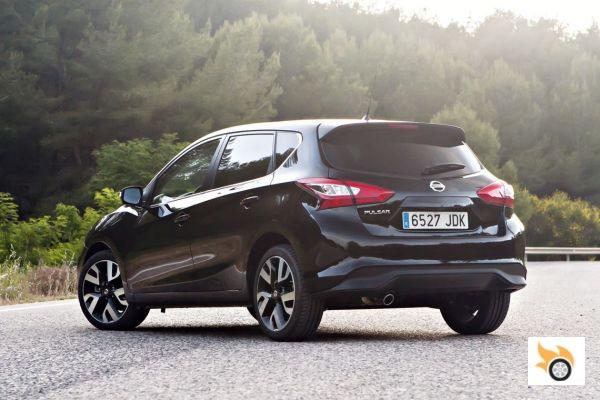
The aesthetics of the Nissan Pulsar will be familiar to many, both customers of the brand and those who are not. It recovers the V-shaped grille whose arms extend upwards defining the lines of the front bonnet, the sharp headlights and in general, the shapes of the Qashqai and X-Trail. Bumpers, tail lights and rear end in general are inspired by the two Nissan SUVs.
Certainly no one will confuse a Pulsar with a Qashqai because it's not as tall as a crossover, but this uniformity of models I don't know if it will end up being detrimental to the brands in the medium term. Audi (from the A4 to the A8) and Mercedes (S-Class and C-Class -and surely future E-Class-) are no longer the only ones to create a design and apply it in different scales across the range. In the end, the public will buy the same model available in several sizes. "S, M, L or XL?", the salesperson will ask...
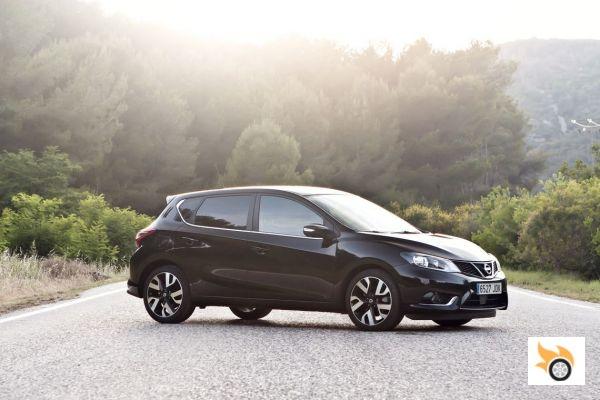
The Pulsar surprises and stands out in the face of so much uniformity in the C segment.
But is there anything to distinguish the Pulsar 190 from a less powerful version? The standard 18-inch alloy wheels and the chrome exhaust tailpipe trim. But as the exhaust tailpipe is still half hidden behind the plastic skirt with its carbon-fibre-like embossing, it's going to be hard to tell a Pulsar DIG-T 115bhp from a 190bhp.
That's not to say that the Pulsar's design is bland, because by going for curvaceous, muscular shapes (just look at the shape of the rear wings and the side waistline), Nissan's compact stands out from its rivals. Between a Kia Cee'd with airs of Audi A3, a Ford Focus full of horizontal lines and a Volkswagen Golf that we all know, the Pulsar surprises and stands out against so much uniformity.
Interior
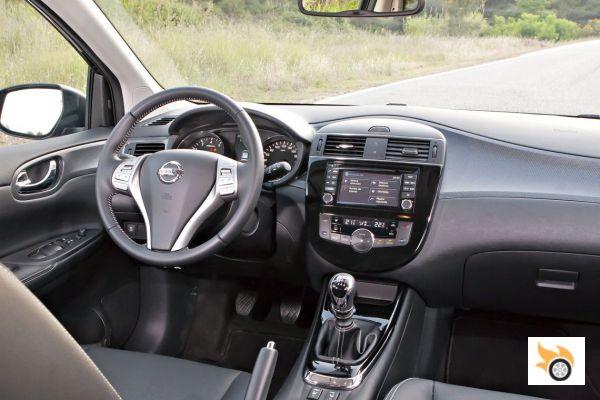
Its dimensions also allow it to stand out. At almost 4.39 m long, it's not exactly the most compact in the segment, but thanks to this it has the luxury of having a wheelbase of 2,700 mm, the longest in the segment. And that's something you can see in the cabin. Rear passengers have the most generous legroom in the segment: 692 mm. This is higher than the C and D-segment average of 562 and 585 mm, respectively. In this section it eclipses all its rivals and even surpasses cars in the upper segment. But the Pulsar not only stands out for its legroom for rear passengers. The width and roominess, in general, are quite good.
It's true that the interior is spacious, very spacious for a C-segment car, but it's not just about space. The shapes of the dashboard and the interior in general are reminiscent of the Qashqai in their design and some of the materials used.
The plastics and the softness of these on the dashboard are at the level of the Qashqai, however the plastics of the doors are somewhat harder and you can see at first glance a difference, something that ends up lowering the overall grade. Otherwise, the finishes are close to those of the SEAT Leon and Peugeot 308 (but there's still some way to go) while surpassing in perceived quality those of the Focus, Kia Cee'd and other rivals. The Golf is still the benchmark in this respect, although the German is increasingly closer to being a premium than a generalist.
It offers enviable roominess for a compact car.
The driving position is good, but the seat doesn't lower much. It's still high at its lowest position, perhaps to bring it closer to the driving position of a first-generation Qashqai. But with the height and depth adjustable steering wheel, it's not difficult to get a comfortable position. Side visibility is good and the A-pillars, for once, didn't seem as thick to me as in other cars. Due to a low rear window, rearward visibility in the rearview mirror isn't the best in the segment, but it's not a problem either. Even less so when it comes to parking if you're equipped with the 360º vision camera.
Being so long, the Pulsar doesn't sacrifice boot volume. At 385 litres, it's in the upper mid-range of the segment. The Peugeot 308 takes the lead here with 432 litres of capacity. The Pulsar also has a fairly low load threshold.
Of course it has asymmetrically folding rear seat backs (40/60), but it's impossible to achieve a completely flat load area. On the other hand, it lacks the modularity of the boot of a Qashqai, for example, as in the Pulsar it is a simple and thin carpet that covers the boot and the hole where the puncture kit is (the spare wheel is optional and of the biscuit type).
Behind the wheel
The Pulsar uses the CMFD platform which allows extreme modularity when creating a model. This is how many of the Pulsar's components come from the Qashqai, such as the complete steering (column, assistance and even the steering wheel). Others are specific to the Pulsar and others come from different models of the Renault-Nissan Alliance.
Under the bodywork we find a chassis with McPherson struts on the front suspension and a compact torsion beam on the rear axle (hence also the generous boot volume). The suspension layout has been tuned to the specific demands of European drivers, Nissan tells us. Let's see how it goes, then.
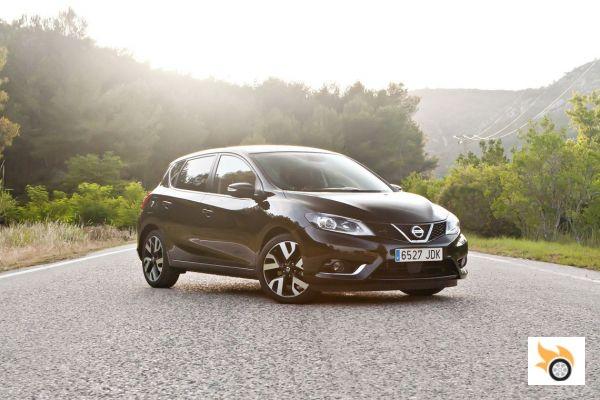
The Pulsar's tuning has been carried out by the team at Nissan's Barcelona technical centre, one of the best-rated within the Alliance. And it shows. The Qashqai's recuperated power steering doesn't communicate anything or almost nothing, but it's quite direct and precise enough, at least for a car that's meant to be a "car for everything", like any other five-door C-segment car. However, unlike the Qashqai where you could choose the degree of hardness, between Comfort and Sport, in the Pulsar you can't. The engineers have kept the Comfort mode. The engineers have retained the Comfort mode, in order to reach a wider audience.
The engine is quiet, almost refined, at constant speed.
The suspension, for its part, knows how to maintain the comfort of the occupants while offering a frank support. Here there is no Audi-style shuffling, when the Pulsar is supported, it stays there and maintains the trajectory without complaining. What is more noticeable than in the Qashqai are the body movements. While the Pulsar does lean into the corner, the bodywork also leans back. The Nissan compact doesn't have the system that acts on the suspension by using the ABS sensors to neutralise body movements through micro-braking to improve comfort. This is a function that is activated with the Sport mode of the steering on the Crossover, a mode that the Pulsar lacks.
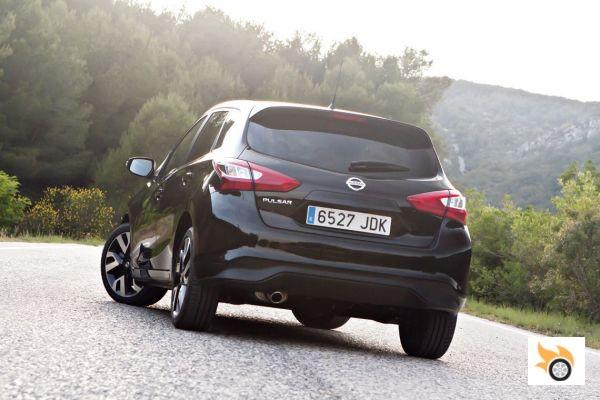
To talk about agility in the case of the Pulsar would be an exaggeration, clearly understeering on corner entry and at a strong pace, it manages to take the tightest corners without pulling out in front. The Active Line Control has a lot to do with that. This system analyses the car's behaviour and trajectory and provides subtle braking to certain wheels to emulate the action of a limited slip differential. In any case, a SEAT Leon would go faster through the same bends thanks to its greater poise and more incisive front end.
The tuning favours comfort while maintaining an encouraging dynamic touch.
So far, the Pulsar 190 bhp is similar to any other model in the range, however, this 1.6 litre engine, which it also shares with the Qashqai (163 bhp version), should provide a slightly more rewarding driving experience for its driver thanks to its greater power, but above all thanks to its 240 NM of torque available from 2,000 to 4,000 revs. In other words, performance should improve significantly. And they do, but the problem is that it is not always noticeable.
First of all, the engine is very quiet. Between the car's high level of comfort and the refinement of its engine, the Pulsar 190 hp is almost a refined car. In terms of performance, the 0 to 100 km/h is executed in 7.7 seconds (compared to the DIG-T it gained 3 seconds). However, despite this improvement in normal or sporty driving, the extra torque is not always noticeable. What's more, you always have the feeling that there's nothing below 3,000 rpm, when in fact you've had maximum torque for 1,000 rpm. What's the problem? The exaggeratedly long gear ratios of the last 3 gears.
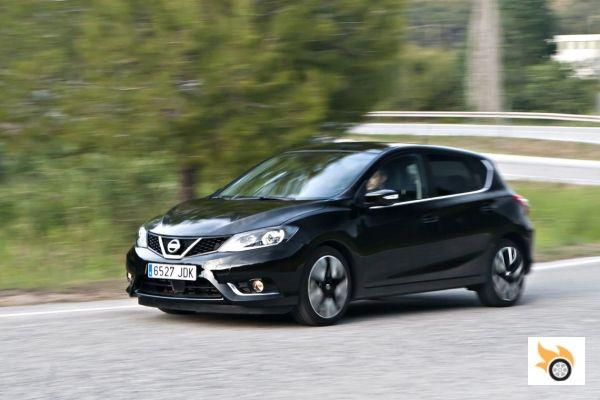
To measure the power of an engine, its response and the liveliness of the whole powertrain, the industry measures the time it takes to go from 80 to 120 km/h in fourth gear (if it's a manual gearbox, of course). In the case of this Pulsar, it took 8 seconds to go from 80-120 km/h in fourth gear. And that explains its bad mark in "performance". Out of curiosity I also measured it in third gear. And things improved a lot, as it took 5.8 seconds; a very honourable time.
At least, the high gears are good for fuel economy. Nissan advertises an average of 5.9 l/100 km, in the test we measured 7.4 l/100 km. Here it all depends on how nervous you are with the gearbox. If you don't want a strong "repris" from the engine by not fiddling with the gearbox, you might be able to get close to 7 l/100 km. If on the other hand, like me, you are exasperated by having 240 Nm under your foot and not noticing them, you end up downshifting and accelerating, so consumption will be close to 8 l/100 km. But then again, these aren't such bad figures for a 190 hp supercharged engine.
Equipment
The Pulsar DIG-T 190 PS is available with just one trim level, the Tekna. This is the most comprehensive of the Pulsar range, as it includes everything from dual climate control, Stop & Start, six airbags, Bluetooth connectivity and four electric windows to 'Intelligent Protection Shield', NissanConnect, 360° Vision Camera, Emergency Braking and LED headlights as standard. Even leather upholstery, with white contrast stitching, and heated seats are standard.
And all this for 27,138 euros, which works out at 23,888 euros if you trade in a used car at the time of purchase. This puts it on a par with a 180 hp SEAT Leon FR (24,090 euros) to which two or three options, such as leather upholstery, would have to be added. Compared to a 150bhp Volkswagen Golf Sport 1.4 TSI (the most powerful petrol car before the GTI), the Pulsar is definitely the better proposition in terms of price/equipment ratio, as the Golf costs around 28,000 euros. It's true that there are slightly more affordable propositions, such as the 182bhp Ford Focus 1.5 EcoBoost. Although the Focus offers a more gratifying dynamic behaviour than the Pulsar, its initial 24,475 euros turn into almost 27,000 euros with similar equipment. Of course, Ford's aggressive sales policy can get you the 182bhp Focus for less than 19,000 euros with promotions...
Conclusion
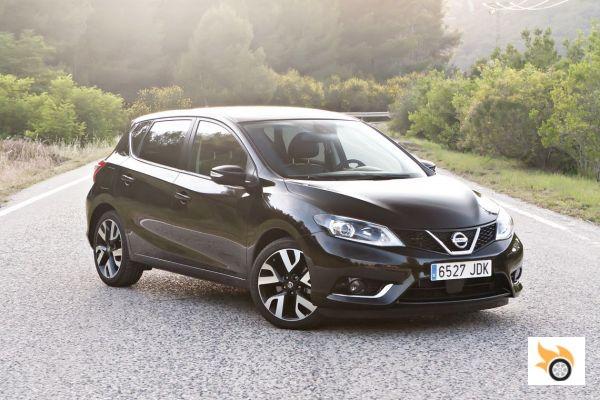
Entering the toughest and most competitive segment of the demanding European market after 14 years of absence is not something to be done lightly, so will the Pulsar be able to reach the 63,000+ units per year the brand expects in Europe? The customer base is unpredictable, but the Pulsar has good arguments to make it happen. Dynamism, habitability, equipment, the Pulsar has almost everything. And this 190 bhp DIG-T version would be the perfect showcase for it... if only they had dared to give it a sporty touch in its tuning and presentation; a bit like the Peugeot 308 GT and SEAT Leon FR.
























